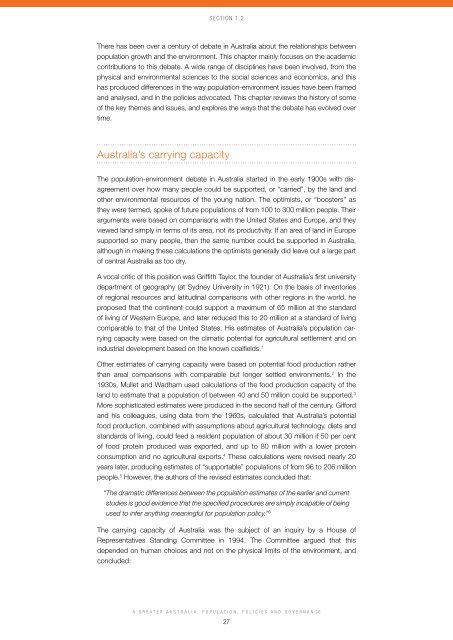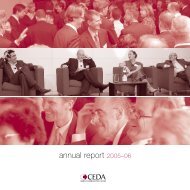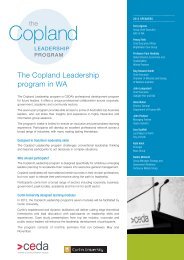A Greater Australia: Population, policies and governance - CEDA
A Greater Australia: Population, policies and governance - CEDA
A Greater Australia: Population, policies and governance - CEDA
- No tags were found...
Create successful ePaper yourself
Turn your PDF publications into a flip-book with our unique Google optimized e-Paper software.
Section 1.2There has been over a century of debate in <strong>Australia</strong> about the relationships betweenpopulation growth <strong>and</strong> the environment. This chapter mainly focuses on the academiccontributions to this debate. A wide range of disciplines have been involved, from thephysical <strong>and</strong> environmental sciences to the social sciences <strong>and</strong> economics, <strong>and</strong> thishas produced differences in the way population-environment issues have been framed<strong>and</strong> analysed, <strong>and</strong> in the <strong>policies</strong> advocated. This chapter reviews the history of someof the key themes <strong>and</strong> issues, <strong>and</strong> explores the ways that the debate has evolved overtime.<strong>Australia</strong>’s carrying capacityThe population-environment debate in <strong>Australia</strong> started in the early 1900s with disagreementover how many people could be supported, or “carried”, by the l<strong>and</strong> <strong>and</strong>other environmental resources of the young nation. The optimists, or “boosters” asthey were termed, spoke of future populations of from 100 to 300 million people. Theirarguments were based on comparisons with the United States <strong>and</strong> Europe, <strong>and</strong> theyviewed l<strong>and</strong> simply in terms of its area, not its productivity. If an area of l<strong>and</strong> in Europesupported so many people, then the same number could be supported in <strong>Australia</strong>,although in making these calculations the optimists generally did leave out a large partof central <strong>Australia</strong> as too dry.A vocal critic of this position was Griffith Taylor, the founder of <strong>Australia</strong>’s first universitydepartment of geography (at Sydney University in 1921). On the basis of inventoriesof regional resources <strong>and</strong> latitudinal comparisons with other regions in the world, heproposed that the continent could support a maximum of 65 million at the st<strong>and</strong>ardof living of Western Europe, <strong>and</strong> later reduced this to 20 million at a st<strong>and</strong>ard of livingcomparable to that of the United States. His estimates of <strong>Australia</strong>’s population carryingcapacity were based on the climatic potential for agricultural settlement <strong>and</strong> onindustrial development based on the known coalfields. 1Other estimates of carrying capacity were based on potential food production ratherthan areal comparisons with comparable but longer settled environments. 2 In the1930s, Mullet <strong>and</strong> Wadham used calculations of the food production capacity of thel<strong>and</strong> to estimate that a population of between 40 <strong>and</strong> 50 million could be supported. 3More sophisticated estimates were produced in the second half of the century. Gifford<strong>and</strong> his colleagues, using data from the 1960s, calculated that <strong>Australia</strong>’s potentialfood production, combined with assumptions about agricultural technology, diets <strong>and</strong>st<strong>and</strong>ards of living, could feed a resident population of about 30 million if 50 per centof food protein produced was exported, <strong>and</strong> up to 80 million with a lower proteinconsumption <strong>and</strong> no agricultural exports. 4 These calculations were revised nearly 20years later, producing estimates of “supportable” populations of from 96 to 206 millionpeople. 5 However, the authors of the revised estimates concluded that:“The dramatic differences between the population estimates of the earlier <strong>and</strong> currentstudies is good evidence that the specified procedures are simply incapable of beingused to infer anything meaningful for population policy.” 6The carrying capacity of <strong>Australia</strong> was the subject of an inquiry by a House ofRepresentatives St<strong>and</strong>ing Committee in 1994. The Committee argued that thisdepended on human choices <strong>and</strong> not on the physical limits of the environment, <strong>and</strong>concluded:A <strong>Greater</strong> <strong>Australia</strong>: <strong>Population</strong>, Policies <strong>and</strong> Governance27





